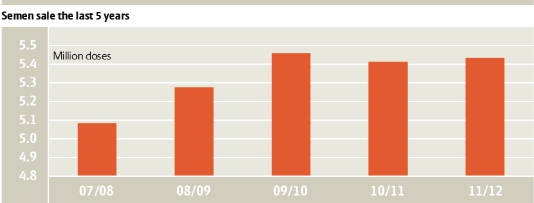



Danish Pig Research Centre Annual Report 2012: AI Research and Development
Sales of semen, auditing AI stations, quality control and recording of semen quality and work on synchronisation and oestrus detection are covered in this section of the report from the Pig Research Centre.Sale of Semen
Sale of semen from DanAvI AI stations increased by 0.4 per cent compared with sales in 2011. Sales amounted to 5.4 million semen doses, corresponding to approx 95 per cent of all matings in Denmark being made with semen purchased from an AI station.

Quality Control
Sperm fertility is assured through quality control of semen as well as materials. Upon collection, each ejaculate is subject to quality control at the AI stations. Quality control procedures also include analyses of:
- sperm number in semen doses
- materials used at the AI stations - are they sperm-toxic?
- quality of semen from Landrace and Large White boars on day 3 after collection.
Today, Computer Assisted Sperm Analyses (CASA) is used for quality control (QC) of semen from Landrace and Large White boars as well as QC for materials used in semen production. Data from these analyses is now used for culling five per cent of Large White boars displaying the poorest semen quality, thus having the greatest risk of reduced fertility. It is currently being investigated whether to introduce this for Landrace as well.
Audit of AI Stations
Pig Research Centre conducts a range of unannounced audits of Danish DanAvI AI stations. The aim is to ensure that AI stations comply with the guidelines for sperm number in a semen dose. Procedures for unannounced audits are described in 'Guidelines for AI stations'.
In December 2011, unannounced audits were performed at Hatting AI departments Ringsted, Ministergården, Billund and Horsens.
In March 2012, unannounced audits were performed at Hatting AI departments Ringsted, Ministergården, Viborg, Ålborg and Horsens, and of boar stations Mors 1, 2 and Vestsjælland.
In June 2012, unannounced audits were performed at Hatting AI departments Ministergården, Viborg and Odense, and of boar stations Mors 1 and 2.
All audits demonstrated compliance with the guidelines.
Recording of Sperm Quality
Recording of sperm quality involves several activities ranging from recording of sperm defects and motility to advanced analyses of biochemical markers on the sperm. The aim is to improve the projection of sperm motility through objective methods - methods that do not depend on a person evaluating sperm in a micro scope.
Pig Research Centre has developed an instrument capable of recording whether sperm are normal and motile. The instrument is being tested on an AI station and results are expected at the beginning of 2013.
Together with Copenhagen University Hospital, Pig Research Centre is also working on developing new methods for analysing sperm quality.The aim is to develop a range of analyses to predict semen fertility before the semen is sold to Danish pig producers.
Stimulation and Oestrus Detection
It is possible to reduce the time spent on service. Results from Pig Research Centre have previously demonstrated that it is not actually necessary to stimulate the sow during insemination. It is now being investigated whether it is possible to reduce the time spent on stimulation before insemination as well.
Sows in the control group are stimulated and subject to oestrus detection according to the five-point plan for duration of one minute and subsequently stimulated as the technician sits on the back of the sow during insemination. In the trial group, stimulation is initiated with the five-point plan that stops once the technician is convinced the sow will display standing oestrus. Results were expected by the end of 2012.
All activities are co-financed by DanAvI AI stations. The projects are also financially supported by the EU and the Rural District Programme under the Danish Ministry of Food, Agriculture and Fisheries journal no.3663-D-10-00461.
May 2013







